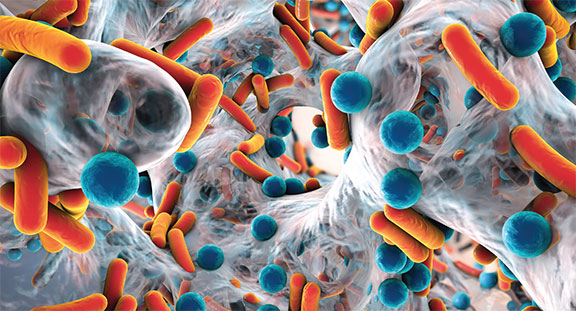Laura E. Levin, MD, with Mary Beth Nierengarten

For patients with epidermolysis bullosa (EB), ongoing care of blisters and wounds caused by mechanical trauma to fragile skin is critical to prevent infection and sepsis. To do this, dermatologists need a good understanding of the types of microbes commonly infecting these wounds to ensure appropriate treatment within the context of antibiotic resistance and the associated challenges. Also important is a better understanding of the risk some patients may face of developing squamous cell carcinoma (SCC).
A recent multicenter study published in Pediatric Dermatology provides descriptive information on these issues, and highlights important areas for further research to guide clinical practice. 1 Led by first author Laura E. Levin, MD, Assistant Professor of Clinical Dermatology, and senior author Kimberly D. Morel, MD, Associate Professor of Clinical Dermatology, both at Columbia University-Irving Medical Center, New York, New York, the study broadens the understanding of the type of microbes most commonly seen colonizing or infecting patients with EB seen at multiple centers in the US and Canada, and the need for thoughtful management strategies given evidence of the prevalence of antibiotic-resistant bacteria colonizing or infecting these wounds. The study also provides some descriptive data on the role bacteria-induced inflammation may play in the development of SCC in some patients.
As with other studies, including a single-center observational study published by Singer and colleagues that reported on the most common bacteria isolated from the wounds of EB patients,2 the multicenter study found that numerous organisms colonize and infect the wounds of patients with EB, particularly multiple staphylococcal species.
Of particular importance for clinical management of these patients is the finding of the high rate of antibiotic-resistant microbes colonizing these wounds. Nearly half of patients with Staphylococcus aureus (SA)-positive cultures had methicillin-resistant SA (MRSA), and 40% of patients treated with mupirocin (a topical antibiotic that is active against staphylococcal species and certain gram-negative bacteria and a cornerstone for decolonization regimens of methicillin-resistant SAs) developed resistance.
Common microbes in EB wound cultures
The study used data from the EB Clinical Characterization and Outcomes Database (EBCCOD) to retrospectively assess wound culture results from EB patients submitted to the repository between 2001 and 2018 from 13 participating centers. Of the total 717 patients registered, they identified 158 (49% women and 51% men) who had a recorded wound culture. By subtype, most patients had dystrophic EB (69%) with the majority of these having recessive dystrophic EB (90%). Other subtypes included EB simplex (13%), junctional EB (14%), and dominant dystrophic EB (9%).
Overall, 739 wound culture results were recorded from the 158 patients and included cultures from 689 superficial swab and 19 tissue samples. Cultures positive for at least 1 microbe growth were seen in 641 of the 739 wound cultures, with 98 cultures showing no microbial growth. Overall, 90 (57%) of patients had clinically infected wounds of which purulent exudate was the most common clinical feature. Table 1 lists the most common microbes found in 152 of the 158 patients with at least one positive culture result (6 patients had negative cultures).
| Table 1. Most common microbes | |
| Microbe | Number of patients (%) |
| Staphylococcus aureus | 131 (86%) |
| Pseudomonas aeruginosa | 56 (37%) |
| Streptococcus pyogenes | 34 (22%) |
| Corynebacterium spp. | 31 (20%) |
| Proteus spp. | 17 (11%) |
Other less-common microbes included coagulase-negative staphylococci and Streptococcus agalactiae (Group B) (each 7%); Serratia marcescens (5%); Enterococcus spp. (4%); Klebsiella pneumoniae and Klebsiella oxytoca (each 7%), and Enterobacter spp. and Acinetobacter spp. (each <3%).
The study also looked at isolate susceptibilities, including beta-lactam susceptibility and mupirocin susceptibility testing (Table 2).
| Table 2. Isolate susceptibilities | |
| Beta-lactam susceptibility testing* | 68% of patients had positive growth of methicillin-susceptible SA (MSSA)47% of patients had positive growth of methicillin-resistant SA (MRSA) 15% of patients had positive growth of MSSA and MRSA at different times. |
| Mupirocin susceptibility testing** | 11 patients had positive growth of mupirocin-susceptible (mupS) SA.6 patients had positive growth of mupirocin-resistant (mupR) SA (50% of these SA isolates were MRSA).2 patients had positive growth of both mupS and mupR. |
*132 patients with 117 cultures that grew Staphylococcus aureus (SA); ** 15 patients
“Given the prevalence of methicillin resistance and mupirocin resistance found in the study, my colleagues and I emphasize the importance of surveillance cultures with routine testing that includes mupirocin susceptibility testing to help guide the appropriate use of antibiotics,” said Dr. Levin. She underscored that a better understanding is needed on microbial colonization and progression over time to help guide clinical decision-making.
“Further understanding of those microbes that may be more pathogenic is needed,” she said. “Future directions should include prospective studies looking at microbes and how they correlate with clinical features of the wound.”
Wound cultures and skin cancer
To gain a better understanding of the potential link between microbes or infections in EB patients and skin cancer risk, the investigators also gathered pilot data to provide descriptive data. Of the 717 patients in the EBCCOD registry, 23 had SCC and of these 10 had wound culture data. Table 3 provides a comparison of common microbe isolates found in the percentages of patients with SCC and without SCC in those with wound cultures (10 and 142, respectively).
| Table 3. Wound cultures and SCC | ||
| Microbe isolate | 10 patients with SCC (%) | 142 patients without SCC (%) |
| SA | 90% | 83% |
| PA | 50% | 34% |
| Proteus spp. | 20% | 11% |
SCC, squamous cell carcinoma; SA, Staphylococcus aureus; PA, Pseudomonas aeruginosa
Dr. Levin noted that these data are purely descriptive and not meant to prove or disprove any association as this is not possible from the data. “We need more of an understanding before we can draw any associations or statistically significant results,” she emphasized.
References
- Levin LE, Shayegan LH, Lucky AW, et al. Characterization of wound microbes in epidermolysis bullosa: results from the epidermolysis bullosa clinical characterization and outcomes database. Pediatr Dermatol. 2021;38:119-124.
- Singer HM, Levin LE, Garzon MC, et al. Wound culture isolate antibiograms and caregiver-reported skin practices in children with epidermolysis bullosa. Pediatr Dermatol. 2018;35(1):92-96.
Disclosures
Dr. Levin reports no relevant financial interests.


